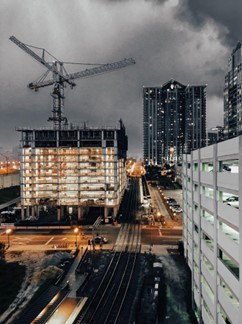Sustainable construction practices advice, Building business guide, Consumers of minerals and natural resources tips
Sustainable Construction Practices
18 May 2022
In the modern world, companies need to be more aware of their impact on the environment. Consumers are increasingly choosing to avoid companies that are irresponsible with their impact on the environment. As a result, there’s increasing pressure on all businesses to look for ways to improve their sustainability.
The construction industry is one of the largest consumers of minerals and natural resources. According to recent research, construction accounts for 50% of all natural resource extraction worldwide. In addition, the industry contributes to 23% of all air pollution, 40% of water pollution and 50% of landfill waste. Clearly, action needs to be taken to ensure that sustainable construction practices are adopted and followed.

photo by Nathan Waters on Unsplash
What Are Sustainable Construction Practices?
Many construction companies are now realising the value of sustainable and green construction approaches. With a growing interest in sustainability and energy saving, new advancements in technology, materials, and practices have been developed in the last decade to enable and promote overall efficiency. As these techniques become more widespread, the construction industry has a higher chance of becoming more environmentally friendly.
Materials are one of the most effective ways to incorporate sustainability into construction. Technological advances have paved the path for a new generation of more durable, lighter, and renewable building materials. Eco fibre cement cladding, such as from https://fibrecementstore.co.uk/, offer a way to provide practical results while still being environmentally friendly. Fibre cladding is more sustainable than a concrete finish and offers high strength, durability, fire resistance and flexibility.
These environmentally friendly materials also contribute to a cleaner environment by lowering the carbon footprint of buildings that use them. They serve the same purpose as their non-renewable counterparts while being more sustainable, energy-efficient and attractive. The only downside is that they can cost more, but the advantages usually outweigh this. Over time, as more sustainable options become available and commonplace, it’s likely that costs will decrease.
Sustainable construction practices aren’t just about the use of renewable and recycled materials, however. They also involve cutting down on waste, conserving energy, constructing green buildings and adaptive reuse projects for old buildings. All of these practices can be used by construction companies to help create healthier and more sustainable construction sites. These practices should aim to help the environment as well as support the well being of those that live in the area.
Challenges of Sustainable Construction Practices
While sustainable construction practices are becoming more commonplace, they can sometimes be challenging to implement. Adopting sustainable construction methods does not happen immediately; there are obstacles to overcome, the most significant of which is cost. Construction companies will always be under pressure to cut costs wherever they can, but there are still concerns that using sustainable construction practices would cost them more.
According to the World Green Building Trends 2018 Smart Market Report, nearly 40% of UK businesses said that the most difficult aspect of adopting sustainable construction techniques was cost. Almost half of the companies said they expected green buildings to have greater upfront expenses. Managing costs in construction projects can already be a challenge, so adding a new cost will make many construction companies wary.
When you consider that 34% of firms say their clients want greener structures, it’s easy to see why many construction companies are concerned about being caught in the middle of strong demand and high costs. Therefore, it’s likely that there needs to be larger incentives for green construction. Government grants and funding could be applied to construction projects that commit to being sustainable. Over time, these practices will get cheaper to implement as they become more common, but regulatory help can make a difference in the meantime.
Comments on this guide to Sustainable construction practices article are welcome.
Property Designs
Glasgow Architecture Designs – architectural selection below:
50 Bothwell Street Office Redevelopment
Comments / photos for the Sustainable construction practices advice page welcome


